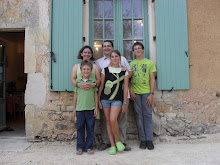Most bulky items are sold in neat flat-packs to be magically assembled at home; climbing frames, bookshelves and even a whole kitchen from Ikea. To successfully put it together one needs to be able to read the instructions, tricky in your second language if you are living in another country. Lacking knowledge of French DIY terms I made a simple metal towel rail back to front, and mixed up all the screws until the boys came to help out and put it together in five minutes. 'How could you misunderstand it? they ask. But there's no time for translation when you are rushing to get the new product finished. Who learnt the conjugations of twist, screw or hammer at school?
There's often a part or tool missing and a trip to the DIY store is unavoidable. Not knowing the right word I feel stupid making a noise like a chain-saw or miming rope for a swing while staff gaze on wondering what I might want. The vocabulary is a black hole of jargon, because if you manage to get a staff member to understand the product you want, they'll ask you ten questions about the material, size, model or price range, until you walk out with anything just to escape.
Some electrical items from major brands come with a handy 200 page multilingual book of instructions. No matter what the linguistic mix in the family each person has their section. The older kids love this instant world language course and flip through the pages saying, 'Look how Hungarians say Plug it in!' or 'That's Chinese for Recharge the Battery'.
I hope that the translators did a good job from the original version, and didn't just cut and paste it the text into one of those free translating websites to save time. Although multilingual instructions are a lifesaver for the OPOL family, there is just one technical problem, flicking from the French version to the English pages to check the translation wastes time. While I'm painstakingly learning new words, 'A screwdriver is a tournevis...', my husband is left holding up one end of a cupboard with his shoulder and is not amused. So we revert to a more simpler communication 'Pass that red thing over there!'
Subscribe to:
Post Comments (Atom)



No comments:
Post a Comment